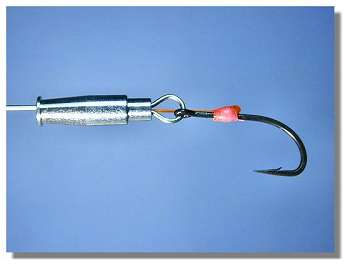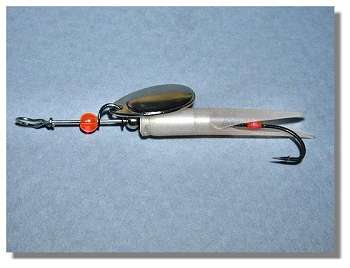|
The Flyrod C and Other Misadventures
By Bob Kenly

An Idea Is Born
Like so many ideas, the concept for the Flyrod C was born in a bar over drinks, in this case Mykels, a local restaurant in Soldotna, Alaska. Three of us, Linda our hostess, Devere my fishing partner and I had one of the most successful salmon outings we had ever experienced on the Kenai River easily out fishing everyone around us, all due to finding some Flying C’s in a local fishing shop. High winds and rain prevented us from reaching the salmon, so reluctantly we resorted to spin gear.
We had purchased some of the local favorite lures in a shop where I found the C’s, as I understand it was the first year they were for sale (Mepps) targeting Alaska salmon. By 4:00 in the afternoon Devere and I were totally wasted and we decided it was time for the “cocktail hour”, with Linda complaining about the two “wimpy fishermen from Missouri” we headed off to repair our shattered bodies with liquid refreshments. Wine for Linda who drank hers like a lady, Devere and I opting for Scotch, drinking ours like we’ve been marooned in the Arctic for ten years.
After repairing Devere’s cramped hand and my sore knee internally with the “Golden Mead” Linda threw out a challenge, “Look, if the Flying C is such a good spinning lure, why doesn’t somebody make a fly rod version”? “No problem” was my answer, starting on the quest for what turned out to be series of failures and ego deflating trials before I came close to an acceptable version.
The Giant Flop
The next year I came up with what I thought was a sterling idea, sort of a rubber bodied fly with a split tail and a large tinsel collar. Proud of this first effort I sent several to Linda so she could wow the rest of the locals with her new salmon fly. She had just finished knee surgery so even the simple act of getting into her waders was a monumental struggle, finally devising a method by laying on the ground, throwing her waders at her feet and wiggling into them.

The Homer Spit Lagoon on
a "quiet" day. There are certain rules of
behavior to be followed in this Alaskan style of fishing but nobody
can
ever tell me what they are or who is or is not following them.
Here I must tell you that Linda is well known on the Kenai Peninsula as a prominent business woman and this outing took place at the famous (or infamous if you choose) Homer Spit which on that day was crowded with locals who like Linda were targeting the King salmon crowding the shore. She had devised a method of getting into the surf with crutches, tying each crutch to herself with a length of rope, once in her spot she discarded the crutches to be retrieved later. Dragging all of her gear to where she thought would be a good spot to fish caused quite a stir among the rest of the fishermen but Linda being Linda took little notice of the commotion that surrounded her and started her quest for a fresh run King. On her first cast she caught a Sculpin, a huge Jurassic looking Sculpin which Alaska is noted for, certainly not anything you would want to keep or eat. Cast after cast got the same results and of course the talk around the Spit was about the “Sculpin Lady” and a lot of remarks about how she would cook a Sculpin or worse where could they buy a “Sculpin Fly”. By now Linda had all she could stand of this sort of humor, packed up her gear, went home to send me an e-mail letting me know exactly what and where I could do with my new fly and keep my crazy ideas home, certainly not stick some unsuspecting Alaskan with them. A good idea that wasn’t even close to good.
A Cry For Help
Defeated but unbowed it became evident that if I ever intended to pursue the idea about a fly rod version of the “Flying C” I’d better get some help from someone who knew what I needed to know about this rubber monstrosity which my European friends called “The Flying Condom” (the meaning which escaped me until I heard the true story from a fisherman in Ireland). I turned to the one person I knew had a clue about this form of madness, Phil Griffiths of the Gordon Griffiths Tackle Company, UK which manufactures 50,000 or so Flying C’s a year in one form or another. Very patiently Phil explained the dynamics of the “Flying C” with is spinner to emit flash and vibration which cased the tail to vibrate. The lure was a huge success because some misguided self proclaimed innovator (that’s me I’m taking about) hasn’t fooled with a design that worked all these years.
Back To The Drawing Board
Next I started into a frenzy of making what I considered to be fly rod sized C’s but all proved to be worthless mostly due to weights which were too heavy for normal fly rod use. When I thought the whole idea was a big waste of time I hit on the idea of using 15 mm aluminum bottle tubes invented by Martin Joergensen
(www.globalflyfisher.com), Denmark and manufactured by Bidoz of France. That combination along with 4mm Flying C rubber from the Griffiths Company and size #0 French blades produced a device that could easily be handled by a #7 wt or #8 wt rod. Now it was time for some serious testing, that is if I hadn’t frightened everyone away and was willing to try my little beast.

The Great Sculpin fly,
another good idea that wasn't even close
Finding Willing Testers
By now many of my friends simply refused to even answer my e-mails whenever I mentioned my latest project so I turned to several close friends who would politely would at least try the new C models. Arthur from Northern Ireland and Rex from Denmark were my first victims, trying them on Sea trout, both were pleased with the results, Finally I did something right after all, next was a friend from my airline days and his son who fished Taneycomo (here in Missouri) for Rainbow trout. Again better results than I thought possible, in four days about 100 trout hooked up both day and night.
Keeping the whole affair secret was becoming more difficult so I rushed several to Davy Wotton, the one person I knew would try a new idea and be brutally honest of anything I came up with. Davy besides being internationally known author, fisherman and artist shares my other passion of the culinary arts (his latest project teaching me the complexities of curry cuisine) so he was the perfect subject. This time it was a light pink model that proved to be successful in Arkansas (Davy now resides in Arkansas running a successful guide operation) on Brown trout and Rainbow trout. By this time I was on a roll but a spine problem prevented me from trying them myself although my Physical Therapist was an avid night trout fisherman so I made him some glow in the dark models, devising a method of just having the tail lit up. Again good results, in fact he tried having the whole body lit up but the glow only tail type out fished everything else.
Making a “Fly Rod C”
Making a “Fly Rod C” is a pretty straight forward affair and finding the metal components are not that difficult but the Flying C rubber may be another story. Flying C rubber supplied by Gordon Griffiths, a high silicone material, available in a wide array of colors. Even if you don’t know what you need Phil has several of my C’s and knows what it takes to put them together:
Gordon Griffiths Fishing Tackle Ltd.
Units 1/8 Lifford Way, Binley Industrial Estate
Coventry CV3 2RN, Great Britain
(Gordon Griffiths has a complete online catalog)
Materials:

Body: 15 mm aluminum Bottle tubes.
Hook: Any single/double or treble although I wouldn’t go bigger than #4.
Mono: Any fairly stiff mono, any color.
Lure Wire: .029 inch (0.734 mm) Note: This is not an exact figure, I tried thinner diameter
stainless lure wire but it tends to bend easily under use.
Flying C Rubber: 4 mm in choice of color.
Thread: Clear nylon sewing thread although any thread of choice can be used.
Epoxy: Devcon 5-Minute Epoxy or any other fast dry epoxy.
Clevis: Small, I prefer the folded kind in Stainless steel.
Blade: #0 French in choice of finish.
Beads: 4 mm plastic or 1/8 inch (6.35 mm) hollow metal beads.
Assembly:
1.

Tie on a piece of mono on top of a hook and epoxy the windings (the only reason for
this is to keep the hook straight). Place the hook in the open loop of the lure wire,
close the loop (just like a safety pin) and push the body all the way to the loop.
2.

While you are assembling the body and hook to the wire also push in
the Mono which is tied on the hook, the mono will keep the hook level while fishing.
3.

Now its time to cut the tail on the rubber. Ideally the ends of the tail have a slight curl to the tips, this is what vibrates when in use. Take a single edge razor blade and press down to make the first cut, try and make the second cut exactly on the other side of the rubber. Generally (and I use that word loosely) what will happen one or more of the tail ends will make a curl.
4.

Slide the rubber on the body and using clear sewing thread tie on to the body (You could use thread if you insist), epoxy the thread to protect it.
5.

Assemble the rest of the lure, make an eye on the wire (needle nose pliers work in a pinch). That’s it, a piece of cake.
So now I can imagine all the European fishermen rolling their eyes in disgust and probably thinking, “Good grief, so now the Yanks have taken over our esteemed FC”. It happened long before I came on the scene with Alaska being the first I ever heard it being used (2002 to be exact). I’m sure it has been tried on other places in North America as we have a long tradition of looking across the “Big Pond” to see what’s working and since the FC worked so well in Europe it doesn’t take long for Americans to jump on the band wagon. My own experiences were driven more by curiosity and a certain obsession to understand the what and why of this thing called a “Flying Condom”.
I’m also not the first to make a fly rod version but I’m probably the first in North America. I knew I was headed in the right direction when a friend called saying, “Hey Bob, the damn thing works”. Since then I’ve had more success with a shrimp design FC that became a huge hit in Kamchatka on all Pacific species available at that time, enough so that the Russian fly fishing magazine NAHLYST has featured in their winter issue albeit my co-author (Juij Shumakov) has been laughingly accused of “Going over to the other side”. Actually I made this shrimp for salt water species but again my plans for a “Break through” fly didn’t work out and I had to rethink my plans for the fame and fortune which usually eludes me.
Revolutions are not absolutely pure movements; they are carried out by humans brewed from internal battles, ambitions and mutual ignorance.
Ernesto “Che” Guevara
Text and photos by Bob Kenly © 2005
Visit Bob's
website
|